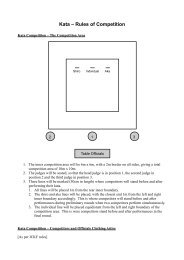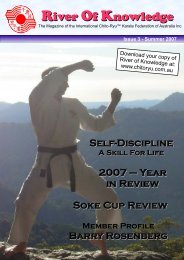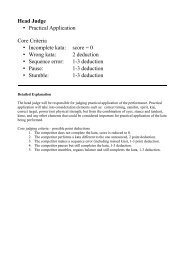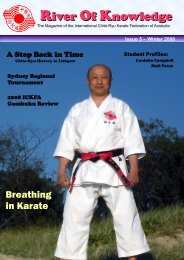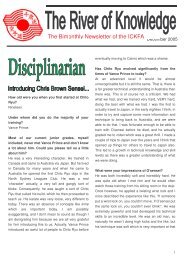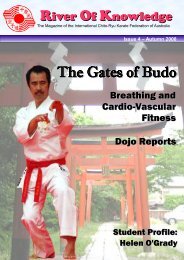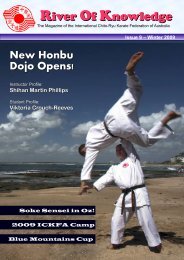River of Knowledge - International Chito-Ryu Karate-do Federation ...
River of Knowledge - International Chito-Ryu Karate-do Federation ...
River of Knowledge - International Chito-Ryu Karate-do Federation ...
- No tags were found...
You also want an ePaper? Increase the reach of your titles
YUMPU automatically turns print PDFs into web optimized ePapers that Google loves.
ICHI GAN – First The EyesSensei Greg FieldIn the last edition <strong>of</strong> the <strong>River</strong> <strong>of</strong><strong>Knowledge</strong> we discussed theconcept <strong>of</strong> ichi gan, ni soku, santan, shi ryoku and how to apply thisin your training. You will recall thatichi gan, ni soku, san tan, shi ryokucan be translated to mean first inimportance is the eyes, second is thestance, third is the tanden and fourthis technique.In this article we will be looking inmore detail at the first part <strong>of</strong> thesaying, ichi gan, or first in importanceis the eyes.In an earlier edition <strong>of</strong> the <strong>River</strong> <strong>of</strong><strong>Knowledge</strong> we considered enzan nometsuke. Enzan no metsuke is theconcept <strong>of</strong> viewing an opponent inthe same way as looking at a distantmountain. An extract from a book byNoma Hisashi 1 may help youunderstand this concept more:The eyes should always be directedtowards the opponent so that hisface occupies the centre <strong>of</strong> visionwhile at the same time remainingaware <strong>of</strong> the opponent in his entirety.One must view the opponent with along focus and be aware at a singleglance <strong>of</strong> his whole aspect, fromhead to foot. When you are at closequarters with the opponent if youfocus only on his face or hands yourfield <strong>of</strong> vision will be very narrow, butif you view him with a feeling <strong>of</strong>distance you will see not only hiswhole figure but also the areas oneither side, without having to movethe eyes.Noma Hisashi provides further words<strong>of</strong> wis<strong>do</strong>m about the correct use <strong>of</strong>the eyes:The purpose <strong>of</strong> correct vision is <strong>of</strong>course to clearly comprehend thesituation but should one becomefixated on a certain point there is thedanger this may cause fear andconfusion. If you look at theopponent’s hands your attention willbe directed to his hands and if youlook to his feet, your attention will bedrawn to his feet. In this situationyou resemble an empty house. Athief could steal into an empty house,as there is no master at home toprevent it. Therefore, keep a broadview and avoid fixated vision.At the beginning, the novice usuallylooks straight at the target he wantsto strike immediately prior to cuttingit. By <strong>do</strong>ing so it is practically thesame as telling the opponent one’sintentions and therefore extremelydisadvantageous.The other concept we need tounderstand is Kan, which in Englishmeans intuitive perception. Kancan be described as seeing youropponent’s intentions. When we talkabout “seeing” here, it is more thanseeing with the eyes but ratherseeing inside your opponent to seetheir thoughts and intentions. NomaHisashi provides this explanation:If asked what Kan is we can say thatit is the most superior <strong>of</strong> senses.First, we sense small things by way<strong>of</strong> the five senses; the eyes forvision, the ears for hearing, the nosefor smell and so on, but if we go astage further, we may even hear thesoundless and see the invisible andbe aware <strong>of</strong> the wonderful and themarvelousNoma Hisashi provides this furtheradvice on Kan:In the midst <strong>of</strong> battle, with its limitlessvariation <strong>of</strong> circumstances, if oneattempts to attack at the momentone recognises a chance it is alreadytoo late. At the moment <strong>of</strong> a bolt <strong>of</strong>lightening, the thunder is released, atthe moment <strong>of</strong> seeing an opportunityto strike, already the opportunity nolongerexists. Therefore, at the moment <strong>of</strong>being aware <strong>of</strong> the existence <strong>of</strong> anopportunity one must already havelaunched in to attack it.How are we to manage this? Theanswer lies ultimately in the use <strong>of</strong>Kan.When one possesses Kan, chancesfor attack project themselves asthough they were reflected in amirror.Kan is obviously a very high levelskill and Noma Hisashi says thatstudents only start to develop thisskill when they are fourth dan. Hisadvice on how to develop Kan is that“all senses develop keennessthrough constant and repetitive use”.So it is only through constant anddiligent training that this skill willdevelop.To finish this article on ichi gan, hereis a quote by Miyamoto Musashifrom The Book <strong>of</strong> Five Rings:Look by the eyes <strong>of</strong> kan, thepr<strong>of</strong>ound and intuitive eye <strong>of</strong> thepsyche. Strengthen the kan and lookinto the heart <strong>of</strong> the opponent, lookat the situation, look widely with theeyes, watch the aspect <strong>of</strong> the battle,watch the weaknesses and strengths<strong>of</strong> your opponent. It is the only wayto discover directly the way to win.I hope this information helps youunderstand the concept <strong>of</strong> ichi ganand why the eyes are first inimportance.Reference: 1. The Ken<strong>do</strong> Reader, Noma Hisashi.<strong>River</strong> <strong>of</strong> <strong>Knowledge</strong> – Spring 2009 14



